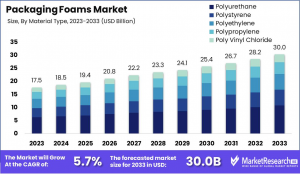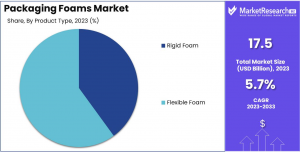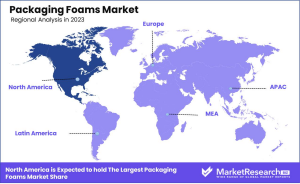Packaging Foams Market to Reach USD 30.0 Bn by 2033, Expanding at 5.7% CAGR
The Packaging Foams Market was valued at USD 17.5 billion in 2023. It is expected to reach USD 30.0 billion by 2033, with a CAGR of 5.7%
North America's dominance in packaging foams is driven by e-commerce demand and growing investments in sustainable foam materials and technologies.”
NEW YORK, NY, UNITED STATES, January 29, 2025 /EINPresswire.com/ -- Market Overview— Tajammul Pangarkar
The Packaging Foams Market was valued at USD 17.5 billion in 2023. It is expected to reach USD 30.0 billion by 2033, with a CAGR of 5.7% during the forecast period from 2024 to 2033.
The Packaging Foams Market involves the production and use of foam-based materials, primarily in the packaging industry, to protect products during transportation and storage. These foams are typically made from materials like polystyrene, polyurethane, polyethylene, and expanded polystyrene, offering benefits such as cushioning, shock absorption, and insulation. Packaging foams are utilized in a variety of sectors, including electronics, food & beverage, automotive, healthcare, and consumer goods.
The Packaging Foams Market has witnessed steady growth, driven by the increasing demand for protective packaging solutions across various industries. With growing consumerism and the rise of e-commerce, the need for safe and secure transportation of products has surged. Companies are increasingly adopting advanced foam materials that offer superior protection while reducing costs. Additionally, the shift towards sustainability is prompting the development of eco-friendly alternatives, further contributing to market expansion. However, rising raw material costs and environmental concerns surrounding non-biodegradable foams are key challenges that businesses must address.
The market’s growth is underpinned by significant investments in packaging innovation, particularly within the electronics and automotive sectors, where product protection is paramount. Governments across various regions are introducing regulations to limit the environmental impact of traditional packaging materials, driving a shift toward recyclable and biodegradable foam products. Moreover, public-private partnerships are expected to foster advancements in sustainable foam solutions, supporting the transition to greener alternatives. This regulatory shift is not only guiding innovation but also presenting growth opportunities for companies that can meet these evolving standards while maintaining cost-effectiveness.
For both new entrants and established players, the Packaging Foams Market presents substantial opportunities. New players can differentiate themselves by developing eco-friendly foam solutions that cater to the growing demand for sustainability in packaging. Additionally, existing companies can leverage innovations in material science to expand their product offerings, diversify into new end-use industries, or enhance their manufacturing processes for greater efficiency. Strategic partnerships and acquisitions also present avenues for market expansion. With rising e-commerce, automotives, and electronics demand, players can tap into new customer segments by offering tailored, protective packaging solutions that address industry-specific requirements.
Curious About Market Trends? Request Your Complimentary Sample Report Today: https://marketresearch.biz/report/packaging-foams-market/request-sample/
Key Takeaway
--The Global Packaging Foams Market was valued at USD 17.5 billion in 2023 and is projected to reach USD 30.0 billion by 2033, growing at a CAGR of 5.7% from 2024 to 2033.
--Polyurethane dominated the market due to its versatility, durability, and excellent cushioning properties.
--Flexible Foam held the largest market share, driven by its wide applications in protective and insulating packaging.
--Anti-Static ESD Foam led the segment, highlighting its critical role in protecting electronic components from electrostatic discharge (ESD).
--Medical and Pharmaceutical industries dominated the market, requiring reliable and protective packaging solutions for medical devices and drugs.
--North America led with a 35% market share, driven by strong demand from the e-commerce sector, stringent packaging regulations, and a shift toward sustainable packaging solutions.
Use Cases
Consumer Electronics Packaging
Packaging foams are widely used in the consumer electronics industry to protect fragile products during shipping. Items such as smartphones, laptops, and other electronic devices require packaging solutions that provide cushioning and prevent damage from impact. Packaging foams, including expanded polystyrene (EPS) and polyurethane foams, are designed to absorb shocks and ensure products reach consumers in perfect condition.
Food and Beverage Packaging
The food and beverage industry also utilizes packaging foams, particularly for perishable goods. Foam trays, containers, and inserts help maintain the freshness and quality of products like meats, seafood, and ready-to-eat meals. Packaging foams provide insulation to keep food items at the right temperature and prevent contamination, making them essential in the modern food packaging industry.
Protective Packaging for Fragile Goods
For products such as glassware, ceramics, and other delicate items, packaging foams offer essential protection. These foams are designed to cushion fragile items and prevent breakage during transportation. Customizable foam inserts are used to fit the exact shape of the product, reducing movement and ensuring that fragile goods arrive safely.
Automotive Industry
Packaging foams are also important in the automotive industry, where they are used for packaging spare parts, accessories, and components. The foams provide cushioning, reduce vibration, and prevent damage to parts during transit. Their lightweight and durable nature make them an ideal choice for packaging automotive products, contributing to cost savings and efficient shipping.
Eco-friendly and Biodegradable Foam Solutions
As sustainability becomes more important, the demand for eco-friendly packaging foams is on the rise. Biodegradable foams made from plant-based materials, such as cornstarch or mushroom, are emerging as alternatives to traditional foam packaging. These materials are more environmentally friendly and offer a sustainable solution for consumers and businesses looking to reduce their environmental impact.
Driving Factors
Growth in E-commerce and Online Shopping: The boom in online shopping has increased the need for protective packaging solutions that ensure products arrive in good condition. Packaging foams, which are lightweight and shock-absorbent, provide excellent protection during transit, making them a popular choice for e-commerce businesses.
Rising Demand for Fragile and High-Value Goods: With an increase in consumer spending on fragile or high-value products like electronics, glassware, and cosmetics, the demand for packaging foams has surged. Packaging foams help protect these items from damage, ensuring that they reach customers intact.
Environmental Concerns and Sustainable Alternatives: As sustainability becomes a priority for both consumers and businesses, there is increasing demand for eco-friendly packaging solutions. While traditional packaging foams (such as polystyrene) have been criticized for their environmental impact, companies are investing in biodegradable and recyclable foam materials, such as those made from cornstarch or recycled content.
Growth in the Automotive and Electronics Industries: Both the automotive and electronics sectors require protective packaging for sensitive components, making packaging foams essential for these industries. The continued expansion of these industries, particularly in emerging markets, is a major driver for the growth of the packaging foams market.
Technological Innovations in Packaging Foam Materials: Advances in material science have led to the development of advanced, more durable, and customizable foam solutions. New types of packaging foams that offer better performance, such as memory foam or molded foam, are attracting industries seeking optimized protection for their products, further driving the market's growth.
Report Segmentation
By Material Type
• Polystyrene
• Polyethylene
• Polyurethane
• Polypropylene
• Poly Vinyl Chloride
By Product Type
• Flexible Foam
• Rigid Foam
By Application
• Inserts
• Corner and edge protectors
• Anti-Static ESD Foam
• Liners
By End User
• Medical and Pharmaceutical
• Food and Beverages
• Aerospace and Defence
• Automotive
• Electrical and Electronics
• Personal Care
• Consumer Packaging
• Others
Ready to Act on Market Opportunities? Buy Your Report Now and Get 30% off: https://marketresearch.biz/purchase-report/?report_id=48261
Regional Analysis
The global packaging foams market shows significant regional variations, with North America dominating, accounting for approximately 35% of global revenue.
This leadership is fueled by strong demand from the e-commerce sector, stringent packaging regulations, and a growing focus on sustainable packaging solutions. The U.S., with its advanced manufacturing capabilities and innovative packaging technologies, plays a key role in maintaining the region’s market supremacy.
Additionally, increasing investments in biodegradable and recyclable foam materials align with consumer and regulatory pressures for eco-friendly packaging alternatives. With continuous advancements in protective packaging and logistics solutions, North America is expected to retain its dominant position in the packaging foams market in the coming years.
Growth Opportunities
Growth in E-commerce and Online Shopping: With the rise of e-commerce, the demand for packaging materials, especially protective packaging like foams, is increasing. Packaging foams are crucial for protecting goods during shipping, and businesses can benefit from this growth by providing lightweight, cost-effective, and protective packaging solutions.
Increase in Consumer Electronics Shipments: As consumer electronics continue to be shipped globally, the need for packaging foams to protect delicate products during transit is growing. Manufacturers of packaging foams can target the electronics sector, offering customized solutions for smartphones, laptops, and other fragile items.
Rising Focus on Sustainability: With growing environmental concerns, there is increasing demand for eco-friendly and biodegradable packaging materials. Companies that develop sustainable foam packaging options, such as foams made from recycled or plant-based materials, can capitalize on this trend and attract environmentally-conscious consumers.
Demand for Lightweight and Cost-Effective Solutions: As companies look for ways to reduce shipping costs, lightweight packaging foams that offer superior protection without adding extra weight are in demand. Manufacturers that focus on creating cost-effective, lightweight foam solutions will see significant growth opportunities.
Growth in the Automotive and Industrial Sectors: Packaging foams are widely used in the automotive and industrial sectors to protect parts and components during transportation. With the expansion of the automotive industry and ongoing industrial growth, businesses can tap into these sectors by providing foam packaging solutions for parts, machinery, and other products.
Key Players
• Sealed Air Corporation
• BASF SE
• Synthos SA
• FoamPartner Group
• Rogers Corporation
• JSP Corporation
• UFP Technologies Inc.
• Synbra Holding bv
• UFP Technologies
• Armacell LLC
• Tosoh Corporation
• ACH Foam Technologies
• FoamCraft Packaging Inc
• Hanwha Corporation
• Plastifoam Company
• Marko Foam Products Inc.
• TotalEnergies
• NCFI Polyurethanes
• Huebach Corporation
• Wasatch Container
• Dongshing Industry Inc.
• Zotefoams Plc.
• Borealis
• Kaneka Corporation
Not Sure? Request a Sample Report and See How Our Insights Can Drive Your Business: https://marketresearch.biz/report/packaging-foams-market/request-sample/
Conclusion
In conclusion, the markets analyzed are all experiencing growth driven by evolving consumer preferences, technological advancements, and increasing demand for customized, high-quality products. Key trends, such as the adoption of sustainable practices, integration of smart technologies, and rising disposable incomes, are shaping the competitive landscape. While challenges such as market saturation, price sensitivity, and regional differences persist, opportunities abound for companies to capitalize on niche segments, leverage digital platforms, and innovate to meet the specific needs of their target audiences. As these industries continue to expand, businesses that adapt to changing trends, prioritize customer-centric strategies, and invest in innovation will be well-positioned for long-term success.
Lawrence John
Prudour
+91 91308 55334
Lawrence@prudour.com
Legal Disclaimer:
EIN Presswire provides this news content "as is" without warranty of any kind. We do not accept any responsibility or liability for the accuracy, content, images, videos, licenses, completeness, legality, or reliability of the information contained in this article. If you have any complaints or copyright issues related to this article, kindly contact the author above.



